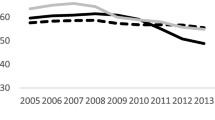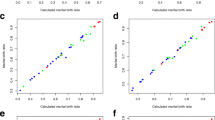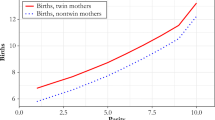Abstract
The identification of parity effects on the hazard of a next birth in cross-family data requires accounting for heterogeneity in fecundity across couples. In a previously published article, Cinnirella et al. Demography, 54, 413–436 (2017), we stratified duration models at the maternal level for this purpose and found that the hazard of a next birth decreases with rising parity in historical England. Clark and Cummins Demography, 56 (2019) took issue with this finding, claiming that the result is a statistical artifact caused by stratification at the maternal level. This reply documents that our previous finding is robust to addressing Clark and Cummins’ critique.






Similar content being viewed by others
Notes
The results presented in this subsection are robust to the use of a predicted measure of the final family size calculated for each birth interval by dividing the time remaining until the age at onset of age-related sterility by the average length of birth intervals. When the same constant values are used for age-related sterility and average length of birth interval for all families (e.g., sample averages), such a predicted measure is not affected by endogeneity concerns (related to, for example, an effect of birth spacing on final family size), which may potentially affect the observed measures.
Furthermore, in our prior study (Cinnirella et al. 2017), we found almost identical effects of the real wage on the timing of the marriage date and the date of the first birth, indicating that the protogenesic interval (in contrast to interbirth intervals) is unrelated to the real wage rate and corroborating the notion that the marriage marked the intention to conceive. (Note that in our prior article, the text “a positive and statistically significant correlation between the real wage and the protogenesic interval” should instead read “a positive and statistically significant correlation between the real wage and the hazard of the first birth” (p. 420).) Indeed, a family-level Cox proportional hazard regression of the protogenesic interval on the real wage rate and the control variables (Cinnirella et al. 2017: Table 3, columns 1–2) yielded an estimate of the hazard rate of wages of 0.99 (p = .40).
These baseline control variables include indicators for the occupation of the father in order to account for additional sources of relevant heterogeneity between families. Our results do not depend on the inclusion of these variables, however.
The marginal effect of mother’s age is computed for the following: net parity 3; no mortality of the previous child; no last birth interval; occupation craftsmen; and not born on January 1, January 11, or December 25.
Furthermore, the joint stratification by parish and quarter-century accounts for location or environment effects specific to each quarter-century.
References
Amialchuk, A., & Dimitrova, E. (2012). Detecting the evolution of deliberate fertility control before the demographic transition in Germany. Demographic Research, 27, 507–542. https://doi.org/10.4054/DemRes.2012.27.19
Anderton, D. L., & Bean, L. L. (1985). Birth spacing and fertility limitation: A behavioral analysis of a nineteenth century frontier population. Demography, 22, 169–183.
Bengtsson, T., & Dribe, M. (2006). Deliberate control in a natural fertility population: Southern Sweden, 1766–1864. Demography, 43, 727–746.
Cinnirella, F., Klemp, M., & Weisdorf, J. (2017). Malthus in the bedroom: Birth spacing as birth control in pre-transition England. Demography, 54, 413–436.
Clark, G., & Cummins, N. (2019). Randomness in the bedroom: There is no evidence for fertility control in pre-industrial England. Demography, 56(4).
David, P. A., & Mroz, T. A. (1989a). Evidence of fertility regulation among rural French villagers, 1749–1789: A sequential econometric model of birth-spacing behaviour (Part 1). European Journal of Population, 5, 1–26.
David, P. A., & Mroz, T. A. (1989b). Evidence of fertility regulation among rural French villagers, 1749–1789: A sequential econometric model of birth-spacing behaviour (Part 2). European Journal of Population, 5, 173–206.
Dribe, M., & Scalone, F. (2010). Detecting deliberate fertility control in pre-transitional populations: Evidence from six German villages, 1766–1863. European Journal of Population, 26, 411–434.
Ejrnæs, M., & Pörtner, C. C. (2004). Birth order and the intrahousehold allocation of time and education. Review of Economics and Statistics, 86, 1008–1019.
Galor, O., & Klemp, M. (2019). Human genealogy reveals a selective advantage to moderate fecundity. Nature Ecology & Evolution, 3, 853–857.
Klemp, M., & Weisdorf, J. (2019). Fecundity, fertility, and the formation of human capital. Economic Journal, 129, 925–960.
Kolk, M. (2011). Deliberate birth spacing in nineteenth century Northern Sweden. European Journal of Population, 27, 337–359.
Van Bavel, J. (2004a). Deliberate birth spacing before the fertility transition in Europe: Evidence from nineteenth-century Belgium. Population Studies, 58, 95–107.
Van Bavel, J. (2004b). Detecting stopping and spacing behaviour in historical fertility transition: A critical review of methods. Population (English ed.), 59, 117–128.
Van Bavel, J., & Kok, J. (2004). Birth spacing in the Netherlands: The effects of family composition, occupation and religion on birth intervals, 1820–1885. European Journal of Population, 20, 119–140.
Van Bavel, J., & Kok, J. (2010). A mixed effects model of birth spacing for pre-transition populations. History of the Family, 15, 125–138.
Author information
Authors and Affiliations
Corresponding author
Additional information
Publisher’s Note
Springer Nature remains neutral with regard to jurisdictional claims in published maps and institutional affiliations.
Rights and permissions
About this article
Cite this article
Cinnirella, F., Klemp, M. & Weisdorf, J. Further Evidence of Within-Marriage Fertility Control in Pre-Transitional England. Demography 56, 1557–1572 (2019). https://doi.org/10.1007/s13524-019-00787-1
Published:
Issue Date:
DOI: https://doi.org/10.1007/s13524-019-00787-1




